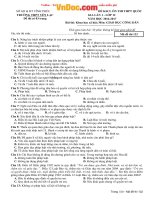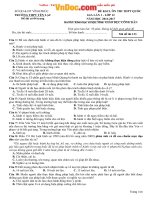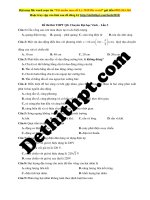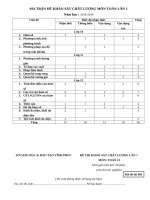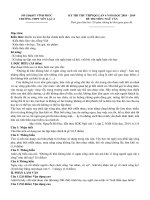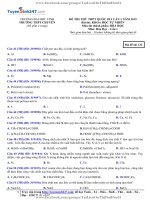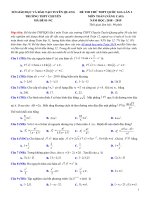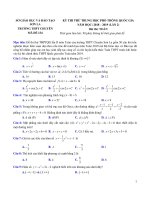De thi thu THPT QG Yen Lac 1 Vinh Phuc Lan 1
Bạn đang xem bản rút gọn của tài liệu. Xem và tải ngay bản đầy đủ của tài liệu tại đây (128.52 KB, 12 trang )
ĐỀ THI THỬ THPT QUỐC GIA
MÔN: TIẾNG ANH
ĐỀ THI TRƯỜNG THPT YÊN LẠC 1 - VĨNH PHÚC – LẦN 1
Mark the letter A, B, C or D on your answer sheet to indicate the word whose underlined
part differs from the other three in pronunciation in each of the following questions.
Question 1: A house
B: cloud
Question 2: A chores
C: blouse
B: halves
D: coupon
C: becomes
D: minutes
Read the following passage and mark the letter A, B, C, or D on your answer sheet to
indicate the correct answer to each of the questions.
Herman Melville, an American author best known today for his novel Moby Dick, was
actually more popular during his lifetime for some of his other works. He traveled
extensively and used the knowledge gained during his travels as the basis for his early novels.
In 1837, at the age of eighteen, Melville signed as a cabin boy on a merchant ship that was to
sail from his Massachusetts home to Liverpool, England. His experiences on this trip served
as a basis for the novel Redburn (1849). In 1841 Melville set out on a whaling ship headed
for the South Seas. After jumping ship in Tahiti, he wandered around the islands of Tahiti and
Moorea. This South Sea island sojourn was a backdrop to the novel Omoo (1847). After three
years away from home, Melville joined up with a U.S. naval frigate that was returning to the
eastern United States around Cape Horn. The novel White-Jacket (1850) describes this
lengthy voyage as a navy seaman.
With the publication of these early adventure novels, Melville developed a strong and loyal
following among readers eager for his tales of exotic places and situations. However, in 1851,
with the publication of Moby Dick, Melville's popularity started to diminish. Moby Dick, on
one level the saga of the hunt for the great white whale, was also a heavily symbolic allegory
of the heroic struggle of man against the universe. The public was not ready for Melville's
literary metamorphosis from romantic adventure to philosophical symbolism. It is ironic that
the novel that served to diminish Melville's popularity during his lifetime is the one for which
he is best known today.
Question 3: The main subject of the passage is_________.'
A Melville’s travels B: Moby Dick
C: Melville’s personal background D: the popularity of Melville’s novels
Question 4: The word “basis” in paragraph 1 is closest in meaning to_________.'
A background B: message C: bottom D: dissertation
Question 5: According to the passage, Melville’s early novels were__________.'
A published while he was traveling
B: completely fictional
C: all about his work on whaling ships
D: based on his travel experience
Question 6: The passage implies that Melville stayed in Tahiti because____________.'
A he had unofficially left his ship
B: he was on leave while his ship was in port
C: he had finished his term of duty
D: he had received permission to take a vacation in Tahiti
Question 7: How did the publication of Moby Dick affect Melville’s popularity?'
A His popularity remained as strong as ever.
B: It caused his popularity to decrease.
C: His popularity increased immediately.
D: It had no effect on his popularity.
Question 8: According to the passage, Moby Dick is__________.'
A symbolic of humanity fighting the universe
B: a single-faceted work
C: a short story about a whale
D: a 47 adventure
Question 9: In what year did Melville’s book about his experiences as a cabin boy appear?'
A 1849 B: 1837 C: 1847 D: 1841
Question 10: The word “metamorphosis” in paragraph 2 is closest in meaning to_________.'
A descent
B: circle
C: mysticism
D: change
Mark the letter A, B, C or D on your answer sheet to indicate the word that differs from the
other three in the position of primary stress in each of the following questions.
Question 11: A counterpart B: communicate
C: attention
D: appropriate
Question 12: A reply
C: protect
D: order
B: appear
Read the following passage and mark the letter A, B, C, or D on your answer sheet to
indicate the correct answer to each of the questions.
The handling and delivery of mail has always been a serious business, underpinned by the
trust of the public in requiring timeliness, safety, and confidentiality. After early beginnings
using horseback and stagecoach, and although cars and trucks later replaced stagecoaches and
wagons, the Railway Mail Service still stands as one of America’s most resourceful and
exciting postal innovations. This service began in 1832, but grew slowly until the Civil War.
Then from 1862, by sorting the mail on board moving trains, the Post Office Department was
able to decentralize its operations as railroads began to crisscross the nation on a regular
basis, and speed up mail delivery. This service lasted until 1974. During peak decades of
service, railway mail clerks handled 93% of all non-local mail and by 1905 the service had
over 12,000 employees.
Railway Post Office trains used a system of mail cranes to exchange mail at stations without
stopping. As a train approached the crane, a clerk prepared the catcher arm which would then
snatch the incoming mailbag in the blink of an eye. The clerk then booted out the outgoing
mailbag. Experienced clerks were considered the elite of the Postal Service’s employees, and
spoke with pride of making the switch at night with nothing but the curves and feel of the
track to warn them of an upcoming catch. They also worked under the greatest pressure and
their jobs were considered to be exhausting and dangerous. In addition to regular demands of
their jobs they could find themselves the victims of train wrecks and robberies.
As successful as it was, “mail-on-the-fly” still had its share of glitches. If they hoisted the
train’s catcher arm too soon, they risked hitting switch targets, telegraph poles or semaphores,
which would rip the catcher arm off the train. Too late, and they would miss an exchange.
Question 13: Which of the following can be inferred from the first paragraph?
A There was a high turnover of railway mail clerks.
B: The development of the mail roads during the second half of the 19thcentury enabled Post
Office Department to focus on timeliness.
C: The Post Office Department was more concerned about speeding up mail delivery than the
safety of its clerks.
D: Mail was often lost or damaged as it was exchanged on the mail crane.
Question 14: The word “elite” in the second paragraph is closest in meaning to___________.
A majority
B: superior
C: more capable
D: leader
Question 15: What does the passage mainly discuss?
A. How the mail cranes exchanged the mail.
B: Improvements in mail handling and delivery.
C: How Post Office Trains handled the mail without stopping.
D: The skills of experienced clerks.
Question 16: According to the passage, the Railway Mail Service commenced in_________.
'
A 1874
B: 1842
C: 1832
D: 1905
Question 17: The word “glitches” in the third paragraph can be replaced by________. '
A accidents
B: blames
C: advantages
D: problems
Question 18: Which of the following is TRUE according to the passage? '
A The clerk booted out the outgoing mailbag before snatching the incoming bag.
B: Clerks couldn’t often see what they were doing.
C: The Railway Mail clerk’s job was considered elite because it was safe and exciting.
D: Despite their success, railway mail clerks only handled a small proportion of all non-local mail.
Question 19: The public expects the following three services in handling and delivery of
mail except___________. '
A safety
B: accuracy
C: confidentiality
D: timeliness
Mark the letter A, B, C, or D on your answer sheet to indicate the sentence that best
combines each pair of sentences in the following questions.
Question 20: We cut down many forests. The Earth becomes hot.
A The more we cut down forests, the Earth becomes hotter.
B: The more we cut down forests, the hotter the Earth becomes.
C: The more forests we cut down, the hotter the Earth becomes.
D: The more forests we cut down, the Earth becomes hotter.
Question 21: I listen to Joe patiently until he started insulting me. At this point, I told him a
few home truths.
A I listened to Joe patiently until he started insulting me, at which point I told him a few
home truths.
B: I told Joe a few home truths, by which time he started insulting me patiently.
C: I told Joe a few home truths after listening to him insulting me patiently.
D: I listened to Joe patiently until he started insulting me, in this case I told him a few home
truths.
Mark the letter A, B, C or D in your answer sheet to indicate the underlined part that needs
correction in each of the following questions.
Question 22: They asked me what did happen last night, but I was unable to tell them.'
A asked
B: did happen
C: but
D: to tell
Question 23: Last year, my little brother got lost when we had gone shopping.'
A when
B: Last year
C: lost
D: had gone
Question 24: There are more than eight four million specimens in the National Museum of
Natural History’s collection of biological, geological, anthropology treasures.'
A collection
B: specimens
C: anthropology
D: treasures
Mark the letter A, B, C or D on your answer sheet to indicate the correct answer to each of
the following question.
Question 25: Becoming an adult and setting up___________ no longer mean the same thing.
A housing
B: housework
C: household
D: housemate
Question 26: Tom: Do you know the man talking to our form teacher?
Peter: Well, he is the doctor who___________ next to my door some years ago.
He___________ abroad and ___________ back.
A lived – had gone – had just come
B: lived – went – has just come
C: had lived – went – just came
D: lived – had gone – just came
Question 27: John contributed fifty dollars, but he wishes he could contribute___________.
A more fifty dollars
B: one other fifty dollars
C: the same amount also
D: another fifty
Question 28: They said they had come back___________.
A the previous day
B: the next day
C: the following day
D: the day after tomorrow
Question 29: They asked me___________ in Los Angeles then.
A whether my father had been working
B: was my father working
C: if my father was working
D: whether was my father
Question 30: Most young people nowadays believe in ___________ marriage – first come
love, then comes marriage.
A romantic
B: arranged
C: unique
D: contractual
Question 31: It’s my wish that he ___________here at this room at 5p.m tomorrow.
A will be
B: is
C: be
D: is going to be
Question 32: Unfortunately, not all candidates can be offered a job, some have to
be___________.
A required
B: rejected
C: remained
D: resigned
Question 33: The proposal will go ahead despite strong___________ from the public.
A objections
B: refusals
C: resistances
D: disagreements
Question 34: The rise in energy___________ has led to a reduction of fossil fuels that the
world must use.
A redundancy
B: consumption
C: efficiency
D: suitability
Question 35: - How much is this car? – 15,000 dollars. My uncle paid for it by___________.
A installments
B: credit
C: hire purchase
D: cash
Question 36: My neighbor is ________photographer; let’s ask him for________ advice
about color film.
Aa-Ø
B: the – the
C: the - an
D: a – the
Mark the letter A, B, C or D on your answer sheet to indicate the most suitable response to
complete each of the following exchanges.
Question
37:
Tom:
“I’m
sorry.
I
won’t
be
able
to
come.”
Jerry:
“____________________________”
A Great!
B: Oh, that’s annoying!
C: Sounds like fun!
D: Well, never mind!
Question 38: Lan: “Well, cats are very good at catching mice around the house.” Mai:
“___________”
A No, dogs are very good, too.
B: Yes, I hope so.
C: You can say that again.
D: Nothing more to say.
Mark the letter A, B, C or D on your answer sheet to indicate the word(s) CLOSEST in
meaning to the underlined word(s) in each of the following questions.
Question 39: It is believed that the plane crash was caused by electrical malfunction of its
navigation system.
A breaking through
B: breaking in
C: breaking down
D: breaking up
Question 40: Billy, come and give me a hand with cooking.
A be busy
B: attempt
C: prepare
D: help
Mark the letter A, B, C or D on your answer sheet to indicate the word(s) O0PPOSITE in
meaning to the underlined word(s) in each of the following questions.
Question 41: John was so insubordinate that he lost his job in one week.
A understanding
B: fresh
C: obedient
D: disobedient
Question 42: He had never experienced such discourtesy towards the president as it
occurred at the annual meeting in May.
A rudeness
B: measurement
C: encouragement
D: politeness
Mark the letter A, B, C or D on your answer sheet to indicate the sentence that is closest in
meaning to each of the following questions.
Question 43: Eight years ago, we started writing to each other.
A We have rarely written to each other for eight years.
B: Eight years is a long time for us to write to each other.
C: We have been writing to each other for eight years.
D: We wrote to each other eight year ago.
Question 44: Keeping calm is the secret of passing the driving test.
A Keep calm or you will pass the driving test.
B: As long as you keep calm, you will pass the driving test.
C: Unless you keep calm, you will pass the driving test.
D: Pass the driving test is without keeping calm.
Question 45: “Why don’t you complain to the company, John?” said Peter.
A Peter suggested John to complain to the company.
B: Peter advised John complaining to the company.
C: Peter suggested that John should complain to the company.
D: Peter asked John why he doesn’t complain to the company.
Read the passage and mark A, B, C, or D to indicate the correct answer to each of the
blanks.
In European and North American cultures, body language behaviors can be divided into 2
groups: open or closed and forward or backward.
Open/closed postures are the easiest to (46)__________. People are open to messages when
they show open hands, face you fully, and have both feet on the ground. This indicates that
they are (47)__________ to listen to what you are saying, even if they are disagreeing with
you. When people are closed to messages, they have their arms folded or their legs crossed,
and they may turn their bodies away. This body language usually means that people are
rejecting your message.
Forward or backward behavior reveals an active or a passive (48)__________ to what is
being said. If people lean forward with their bodies toward you, they are actively engaged in
your message. They may be accepting or rejecting it, but their minds are on (49)__________
you are saying. On the other hand, if people lean back in their chairs or look away from you,
or perform activities such as drawing or cleaning their eyeglasses, you know that they are
either passively taking in your message or that they are ignoring it. In (50)__________ case,
they are not very much engaged in the conversation.
Question 46: A indicate
B: do
C: refer
D: recognize
Question 47: A likely
B: reluctant
C: able
D: willing
Question 48: A reaction
B: opinion
C: behavior
D: knowledge
Question 49: A who
B: what
C: that
D: things
Question 50: A other
B: both
C: either
D: another
Đáp án
1-D
11-A
21-A
31-C
41-C
2-D
3-D
4-A
5-D
6-A
7-B
8-A
9-A
42-D
43-C
44-B
45-C
46-D
47-B
48-A
49-B
10-D
20-C
30-A
40-D
50-C
LỜI GIẢI CHI TIẾT
Câu 1: Đáp án D
House /haʊs/ nhà
Cloud /klaʊd/ mây
Blouse /blaʊs/ áo phông trắng cho nữ
Coupon /ˈkuːpɒn/ phiếu mua hàng
Phương án D có phần gạch chân phát âm là /uː/, các phương án còn lại phát âm là /aʊ
Câu 2: Đáp án D
Chores /tʃɔːrz/ việc nhà
Halves /hɑːvz/ nhiều cái một nửa
Becomes /bɪˈkʌmz/ trở thành
Minutes /ˈmɪnɪts/ nhiều phút
Phương án D có phần gạch chân phát âm là /s/, các phương án còn lại phát âm là /z/.
Read the following passage and mark the letter A, B, C, or D on your answer sheet to
indicate the correct answer to each of the questions.
Herman Melvile, một tác gia người Mỹ, ngày nay nổi tiếng vì cuốn tiểu thuyết Moby Dick,
trong thời mà ơng cịn sống thực ra lại được biết đến nhiều hơn nhờ những tác phẩm khác.
Ông đi rất nhiều và sử dụng kiến thức thu lượm được trong những chuyến đi để làm nền tảng
cho những cuốn tiểu thuyết đầu tiên. Năm 1837, khi 18 tuổi, Melvile làm việc ở cabin trên
một con tàu thương gia đi từ quê nhà Massachusetts đến Liverpool, vương quốc Anh. Kinh
nghiệm trên chuyến đi này chính là nền tảng cho tác phẩm Redburn (1849). Năm 1841,
Melvile lên một con tàu săn cá voi hướng về biển Đông. Sau khi nhảy khỏi tàu ở Tahiti, ông
ấy đi loanh quanh khắp các đảo ở Tahiti và Moorea. Quá trình ở tại đảo của Biển Đơng chính
là phơng nền cho cuốn tiểu thuyết Omoo (1847). Sau ba năm đi xa nhà, Melvile gia nhập với
một tàu khu trục của hải quân Hoa Kỳ đang trở lại phía Đơng Mỹ, xung quanh khu vực Cape
Horn. Cuốn tiểu thuyết “Chiếc áo khoác trắng” (1850) miêu tả chuyến đi biển dài dằng dặc
này ở cương vị một người thủy thủ.
Với việc xuất bản nhiều tiểu thuyết mạo hiểm đầu tiên đó, Melvile đã phát triển được tinh
thần mạnh mẽ và trung thành của đọc giả, mong muốn đón chờ những câu chuyện kể về
những miền đất và tình huống kì lạ của ơng. Tuy nhiên, vào năm 1851, với sự xuất bản của
Moby Dick thì sự nổi tiếng của Melvile bắt đầu giảm xuống. Moby Dick, tầm cỡ như câu
chuyện dân gian về cuộc săn bắt chú cá voi khổng lồ, cũng là một câu chuyện ngụ ý về cuộc
đấu tranh anh hùng của con người chống lại vũ trụ. Công chúng vẫn chưa sẵn sàng cho sự
thay đổi về tư duy văn học của Melvile từ lãng mạn sang trường phái triết học. Thật là trớ
trêu vì cuốn tiểu thuyết mà khiến sự nổi tiếng của Melvile suy giảm thời đó lại là một trong
những cuốn tiểu thuyết nổi tiếng nhất của ông ngày nay.
Câu 3: Đáp án D
Câu đầu tiên của đoạn văn cho ta biết chủ đề của bài: Herman Melville, an American author
best known today for his novel Moby Dick, was actually more popular during his lifetime for
some of his other works. (Herman Melvile, một tác gia người Mỹ, ngày nay nổi tiếng vì cuốn
tiểu thuyết Moby Dick, thực ra lại được biết đến nhiều hơn nhờ những tác phẩm khác trong
thời mà ơng cịn sống).
Và các đoạn sau, bài viết nói về các tác phẩm của ơng. Các chuyến đi dù có được nhắc đến
nhưng chỉ được nhắc đến như là cơ sở để ông viết văn, chứ không phải đoạn văn miêu tả hay
kể về chuyến đi đó.
Nếu lấy nhan đề là Moby Dick, một tác phẩm của ơng, thì đây chỉ là một chi tiết nhỏ, không
đủ bao quát tác phẩm. Nếu lấy nhan đề là nền tảng cá nhân thì cũng khơng được vì trong bài
khơng nhắc đến những tính chất này ngồi những chuyến đi.
Q thầy cơ vui lịng xem bản đầy đủ tại
website />
Câu 41: Đáp án C
Giải thích:
Insubordinate: không nghe lời
Understanding: hiểu biết
Fresh: tươi mới
Obedient: nghe lời
Disobedient: không biết nghe lời
Insubordinate trái nghĩa với obedient.
Dịch: John quá là không biết nghe lời đến nỗi mà anh ta mất việc trong vòng một tuần.
Câu 42: Đáp án D
Giải thích:
Discourtesy: vơ lễ
Rudeness: sự vơ lễ
Measurement: giải pháp
Encouragement: sự thúc đẩy, khích lệ
Politeness: sự lễ phép
Discourtesy trái nghĩa với politeness.
Dịch: Anh ta chưa bao giờ trải nghiệm việc vô lễ với tổng thống như là khi nó xảy ra vào
cuộc họp hàng năm vào tháng Năm.
Câu 43: Đáp án C
Dịch:
Câu gốc: Tám năm trước, chúng tôi bắt đầu viết thư cho nhau.
A. Chúng tôi hiếm khi viết cho nhau trong tám năm rồi.
B. Tám năm là một khoảng thời gian dài cho chúng tôi để viết cho nhau.
C. Chúng tôi đã viết cho nhau trong suốt tám năm.
D. Chúng tôi đã viết cho nhau vào tám năm trước.
Dựa vào nghĩa ta chọn được C.
Câu 44: Đáp án B
Dịch:
Câu gốc: Giữ bình tĩnh là chìa khóa của việc vượt qua bài thi lái xe.
A. Giữ bình tĩnh hoặc bạn sẽ vượt qua bài thi lái xe.
B. Miễn là bạn giữ bình tĩnh, bạn sẽ vượt qua bài thi lái xe.
C. Trừ phi bạn giữ bình tĩnh, bạn sẽ vượt qua bài thi lái xe.
D. Vượt qua bài thi lái xe là khơng cần giữ bình tĩnh.
Dựa vào nghĩa ta chọn được B.
Câu 45: Đáp án C
Dịch:
Câu gốc: “Tại sao bạn không phàn nàn với công ty hả John?”, Peter hỏi.
A. Peter đề nghị John than phiền với công ty.
Thực ra câu này sai cấu trúc: suggest V-ing hoặc suggest (that) somebody V (giữ nguyên thể)
mới đúng.
B. Peter khuyên John than phiền với công ty.
C. Peter đề nghị rằng John nên than phiền với công ty.
D. Peter hỏi John tại sao anh ta lại không than phiền với công ty.
Cấu trúc Why don’t you V? dùng để khun, gợi ý ai đó nên làm gì, nên thực chất là Peter
đang khuyên John phàn nàn với công ty của anh ta.
Read the passage and mark A, B, C, or D to indicate the correct answer to each of the
blanks.
Trong văn hóa châu Âu và Bắc Mỹ, hành vi ngơn ngữ cơ thể có thể được chia ra làm 2 nhóm:
mở và đóng, tiến hoặc lùi.
Cử chỉ mở/đóng là dễ dàng nhận biết nhất. Người ta sẽ cởi mở với những thơng điệp khi mà
họ để mở lịng bàn tay, hướng thẳng về phía bạn và đặt cả hai chân xuống đất. Điều này chỉ
ra rằng họ sẵn lịng lắng nghe những gì bạn nói, dù cho họ đang bất đồng với bạn. Khi người
ta khép mình lại trước các thông điệp, họ sẽ khoanh tay hoặc vắt chéo chân, và họ có thể
quay người đi. Ngơn ngữ cơ thể này thường có nghĩa là người ta đang từ chối thông điệp của
bạn.
Hành vi tiến hay lùi để lộ ra phản ứng chủ động hoặc bị động đối với những gì đã được nói.
Nếu người ta diến cơ thể lên phía trước với bạn, họ đang tích cực tham gia vào thơng điệp
của bạn. Họ có thể chấp nhận hoặc từ chối, nhưng họ đang mở lòng với những gì bạn nói.
Mặt khác, nếu người ta dựa về phía sau ghế hoặc khơng nhìn về phía bạn, hoặc thực hiện
những hành động như là vẽ hoặc lau kính, bạn biết rằng họ đang bị động nhận lấy những lời
nói của bạn hoặc phớt lờ bạn. Trong một trong hai trường hợp đó, họ đều khơng tham gia lắm
vào cuộc hội thoại.
Câu 46: Đáp án D
Indicate: ngụ ý
Do: làm
Refer: nhắc đến
Recognize: nhận ra
Dựa vào nghĩa ta chọn được recognize: cử chi đóng/mở là dễ nhận ra nhất.
Câu 47: Đáp án B
Likely: có khả năng
Reluctant: lưỡng lự
Able: có thể
Willing: sẵn lịng
Dựa vào nghĩa ta chọn được willing: Những điều này cho biết họ sẵn lịng lắng nghe những
gì bạn nói, dù họ có khơng đồng ý với
Câu 48: Đáp án A
Reaction to: phản ứng với điều gì
Opinion about: ý kiến về vấn đề gì
Behavior: hành vi
Knowledge: kiến thức
Dựa vào nghĩa ta chọn được reaction: Việc tiến hay lui cho thấy phản ứng chủ động hay bị
động đối với những gì được nói ra.
Câu 49: Đáp án B
What you are saying: những điều bạn đang nói
Đây khơng phải mệnh đề quan hệ nên khơng dùng who, that; mà bản chất nó là cụm danh từ
với từ để hỏi what.
Câu 50: Đáp án C
Other: khác
Both: cả hai
Either: một trong hai
Another: một cái khác
Ta dựa theo nghĩa của các câu phía trước để chọn đáp án, và lưu ý “case” ở số ít nên không
thể dùng “both”, dù nghĩa của từ “both” cũng phù hợp để điền vào. Mặt khác, nếu người ta
dựa về phía sau ghế hoặc khơng nhìn về phía bạn, hoặc thực hiện những hành động như là vẽ
hoặc lau kính, bạn biết rằng họ đang bị động nhận lấy những lời nói của bạn hoặc phớt lờ
bạn. Trong một trong hai trường hợp đó, họ đều khơng tham gia lắm vào cuộc hội thoại.
